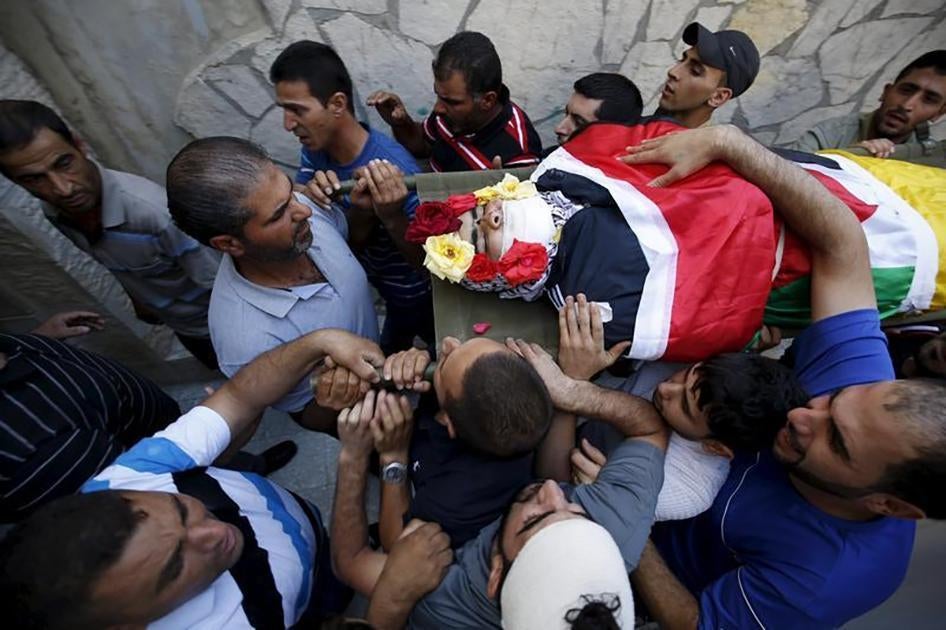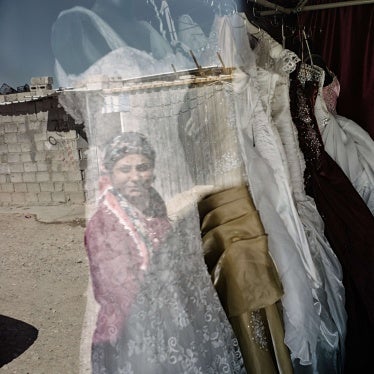(Ramallah) – The evidence in an Israeli colonel’s fatal shooting of a Palestinian boy on July 3, 2015, indicates that the shooting violated international standards on the use of lethal force in policing, and possibly also Israel’s own open-fire regulations. A recently released video supports witness accounts and forensic evidence that Col. Israel Shomer killed Mohammad al-Kasbeh, 17, while al-Kasbeh was fleeing, apparently contradicting the military’s initial statement exonerating the colonel on the grounds that he faced a “mortal danger.”
Video footage obtained by B’Tselem, an Israeli human rights organization, supports accounts by Palestinian witnesses that Shomer, a brigade commander, shot al-Kasbeh in the back as he and others were fleeing after he threw a rock at close range at the windshield of a vehicle carrying the colonel. While a rock directed at a moving vehicle can pose a mortal danger, the fatal shooting appears to have occurred after the colonel left the vehicle and pursued the fleeing rock-thrower.
“A proper investigation into this killing should examine mounting evidence that Colonel Shomer shot Mohammad al-Kasbeh in the back as he fled, and not because he posed any ongoing mortal threat,” said Sarah Leah Whitson, Middle East director.
Palestinian witnesses to the confrontation near the Qalandiya checkpoint south of Ramallah told the media and B’Tselem that they saw two or three soldiers get out of a military vehicle and chase stone-throwing youths, pause, and then shoot at their backs. Human Rights Watch obtained photographs of al-Kasbeh’s body from B’Tselem showing what appear to be three bullet entry wounds – in the upper back, side torso, and jaw. Israel has not performed an autopsy, B’Tselem said.
The grainy video from a nearby surveillance camera appears to show a figure approaching the vehicle as it drives by, throwing an object at its windshield, and fleeing on foot. The vehicle stops immediately, two soldiers get out and pursue the figure, while a third waits by the vehicle. The two soldiers return less than 30 seconds later to the vehicle, which then drives away.
Maj. Gen. Roni Numa, who is the Israeli Defense Forces (IDF) commander of the area in which the incident occurred, concluded on the day of the shooting that Shomer had acted appropriately, according to a statement published on the IDF website. “I fully back the brigade commander and his handling of the situation,” Numa said. Shomer, according to the website, “felt in imminent mortal danger, left his vehicle, and conducted an arrest of a suspect.”
Echoing this claim, Education Minister Naftali Bennett, Deputy Defense Minister Eli Ben Dahan, and the Chairman of the centrist Yesh Atid Party Yair Lapid all publicly came to the support of Shomer, saying he had acted in self-defense.
|
News Release
Israel: Effectively Investigate Boy’s Killing by Colonel
Evidence Appears to Contradict Military’s Account
Your tax deductible gift can help stop human rights violations and save lives around the world.
Region / Country
Topic
Most Viewed
-
January 15, 2026
Syria: Accountability Lacking for Sweida Abuses
-
January 12, 2026
Iran’s Internet Blackout Concealing Atrocities

-
November 25, 2019
A Dirty Investment

-
March 29, 2021
“Everything I Have to Do is Tied to a Man”

-





